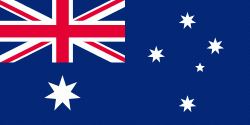Axedale
Axedale is a small town in Victoria, Australia. It is located on the McIvor Highway, in the City of Greater Bendigo, east of Bendigo. It was surveyed and proclaimed in 1861. At the 2016 census, Axedale had a population of 802.
The town is nestled alongside the Campaspe River which feeds out of Lake Eppalock (about 20 minutes drive away). It has a golf course, tennis courts, a school, a pub and a convenience store/petrol station. It lies between Heathcote and Bendigo. Axedale has at least four churches, approximately one for every 220 residents of the town. In years past, it was host to The Titanic Museum, a home-based museum notable for charging fees to behold a 90 cm replica of the famous vessel.
The Post Office opened on 21 April 1862. The town was served by the Axedale railway station on the Heathcote railway line from 1888 until 1941.
The town was the end point of the O'Keefe Rail Trail from Bendigo along the former railway reservation. In 2015, work was completed on extending the rail trail from Axedale to Heathcote. As part of the Campaspe River crossing, an underpass for the Rail Trail was also built under the McIvor Highway.
Golfers play at the Axedale Golf Club on Mitchell Street.
The town is nestled alongside the Campaspe River which feeds out of Lake Eppalock (about 20 minutes drive away). It has a golf course, tennis courts, a school, a pub and a convenience store/petrol station. It lies between Heathcote and Bendigo. Axedale has at least four churches, approximately one for every 220 residents of the town. In years past, it was host to The Titanic Museum, a home-based museum notable for charging fees to behold a 90 cm replica of the famous vessel.
The Post Office opened on 21 April 1862. The town was served by the Axedale railway station on the Heathcote railway line from 1888 until 1941.
The town was the end point of the O'Keefe Rail Trail from Bendigo along the former railway reservation. In 2015, work was completed on extending the rail trail from Axedale to Heathcote. As part of the Campaspe River crossing, an underpass for the Rail Trail was also built under the McIvor Highway.
Golfers play at the Axedale Golf Club on Mitchell Street.
Map - Axedale
Map
Country - Australia
 |
 |
| Flag of Australia | |
The ancestors of Aboriginal Australians began arriving from south east Asia approximately 65,000 years ago, during the last ice age. Arriving by sea, they settled the continent and had formed approximately 250 distinct language groups by the time of European settlement, maintaining some of the longest known continuing artistic and religious traditions in the world. Australia's written history commenced with the European maritime exploration of Australia. The Dutch navigator Willem Janszoon was the first known European to reach Australia, in 1606. In 1770, the British explorer James Cook mapped and claimed the east coast of Australia for Great Britain, and the First Fleet of British ships arrived at Sydney in 1788 to establish the penal colony of New South Wales. The European population grew in subsequent decades, and by the end of the 1850s gold rush, most of the continent had been explored by European settlers and an additional five self-governing British colonies established. Democratic parliaments were gradually established through the 19th century, culminating with a vote for the federation of the six colonies and foundation of the Commonwealth of Australia on 1 January 1901. Australia has since maintained a stable liberal democratic political system and wealthy market economy.
Currency / Language
| ISO | Currency | Symbol | Significant figures |
|---|---|---|---|
| AUD | Australian dollar | $ | 2 |
| ISO | Language |
|---|---|
| EN | English language |















